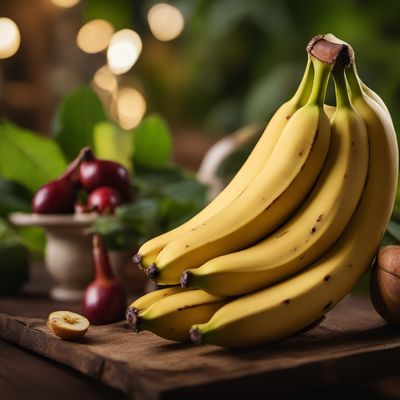
Ingredient
Common banana - paradisiaca cultivars
The Versatile Fruit: Exploring the World of Paradisiaca Bananas
Paradisiaca cultivars, or common bananas, are elongated fruits with a thick peel that varies in color from green to yellow. They have a creamy, soft flesh that is sweet when ripe. The texture is smooth and slightly fibrous, and the fruit is typically seedless. Bananas are known for their distinctive curved shape and are available in various sizes, ranging from small finger bananas to larger dessert bananas. They are a staple in many cuisines around the world and are enjoyed both raw and cooked.
Origins and history
Bananas are believed to have originated in Southeast Asia and have been cultivated for thousands of years. They have a rich cultural and historical significance, being mentioned in ancient texts and depicted in ancient Egyptian hieroglyphs. Bananas were introduced to the Americas by Portuguese explorers in the 15th century and quickly spread throughout the region. Today, they are grown in tropical and subtropical regions worldwide.
Nutritional information
Bananas are a nutritious fruit, rich in potassium, vitamin C, vitamin B6, and dietary fiber. They are also a good source of energy, with approximately 96 calories per medium-sized banana.
Allergens
Bananas are generally not associated with common allergens, making them a safe choice for most individuals. However, some people may have a latex allergy, which can cause cross-reactivity with certain proteins found in bananas.
How to select
When selecting bananas, look for fruits that are firm and free from bruises or blemishes. The peel should be intact and without any signs of mold. Choose bananas with a vibrant yellow color for immediate consumption, or slightly green ones if you prefer them to ripen over a few days.
Storage recommendations
To extend the shelf life of bananas, store them at room temperature until they reach the desired ripeness. Once ripe, they can be refrigerated to slow down the ripening process. However, refrigeration may cause the peel to darken, although the fruit inside remains unaffected.
How to produce
Bananas can be grown by amateur gardeners in tropical or subtropical regions. They require a warm climate, well-drained soil, and regular watering. Planting banana suckers or young plants in a sunny location with protection from strong winds is recommended. Regular fertilization and pruning of dead leaves are essential for optimal growth.
Preparation tips
Bananas can be enjoyed in various ways. They can be eaten raw, sliced and added to breakfast cereals or smoothies, or used as a topping for desserts. Bananas can also be cooked and incorporated into dishes such as banana bread, pancakes, or curries. To prevent browning, sprinkle lemon juice or dip the cut surfaces in citrus juice before using.
Culinary uses
Bananas are incredibly versatile and are used in a wide range of culinary applications. They can be used in baking to add natural sweetness and moisture to cakes, muffins, and bread. Bananas are also commonly used in smoothies, milkshakes, and ice cream for their creamy texture and sweet flavor. In savory dishes, they can be grilled, fried, or used in curries to add a touch of sweetness and balance out spicy flavors.
Availability
Bananas are widely available in tropical and subtropical regions around the world. They are cultivated in countries such as India, Brazil, the Philippines, Ecuador, and Costa Rica.

